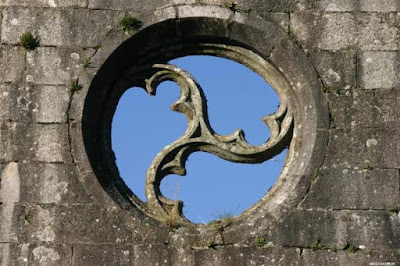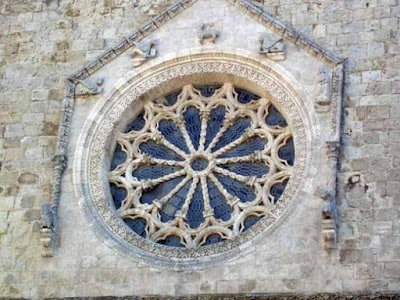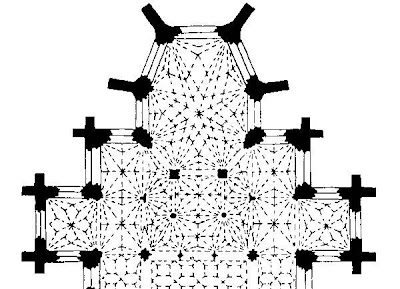I have just been creating a new online course on the mathematics of beauty and as part of this, I wanted to show how to represent the symbolic meaning of number in the context of the liturgy in such a way that it might deepen participation. The obvious way to do this is to have a pattern with the symmetry of the number. This will require also some catechesis of the congregations so that they are reminded of what it is pointing to every time they see it. It can be part of the decoration of the church, incidental, as it were, to the structure:
Or it can be more intimately and obviously bound with the form of the church, as it is in the medieval rose window. Here is a window dating from about 1500 in the cathedral at Amiens in France:
It is important to awaken our innate sense of the symbolism of the natural world and all that is created as this stimulates also our natural sense of the divine. The awe and wonder that we feel when we contemplate the world around us is, for all that it seems profound, little better than a shallow emotion generated artificially by a drug if we stop there and do not allow it to draw us closer to its source - God. This is its true consummation, we are made to see the glory of God in his creation and it will be to his greater glory and our greater joy if we allow the beauty of the world to take us to what it points to.
We can consider this to be a form of relation. Creation is in relation to its Creator. By virtue of its existence, it is relational, for it is connected to its Creator by the mark of divine beauty He has impressed upon it. This interconnectivity of all that exists, therefore, is not a mental construct thrust upon the cosmos artificially by mankind. Rather it is a property of the object that we see. All being is relational by nature and is patterned lattice that has the Creator at its heart.
As created beings ourselves, we participate in this dynamic too, seeing a natural connection between ourselves and the rest of the cosmos. All of mankind is endowed by the Creator with an intellect and the capacity to observe the world around us in such as way that it can derive from it an understanding of our place within it, and ultimately this points to and sheds light on our relationship with the Creator.
Part of our task as people seeking to evangelize the world is to re-awaken the final link in the chain of connection between creation and Creator by re-establishing a culture that is rooted in this principle of interconnectivity through its beauty. This process of evangelization of the culture begins in the church in which all that we perceive and all that we do participates in this language of symbol and is there to connect us to God.
Coming back to the symbolism of number, it is widely accepted, even in the secular culture, that the natural world is connected to mathematics. The connection is so strong that few, if any, doubt, for example, the power of mathematics to help the natural scientist to describe the processes of the natural world. However, I think we should stop for a moment and think about this - it need not automatically be the case. Once I realised this it became a source of great wonder to me that the abstract world of mathematics is so intimately bound in its structure with the behaviour of the natural world.
This had to be noticed before the connection could be made, and it is why figures such as Boethius commented, in his De Institutione Arithmetica, (Bk1, Ch.2) that 'number was the principal exemplar in the in the mind of the Creator' and from this is derived the pattern of its existence that the scientist observes.
The natural scientist of today is generally less aware of the symbolism that runs through both nature and mathematics. The medieval thinker would not have rejected method of today's natural scientists I suggest but would have added to his description of the natural world the symbolic language of number, which is largely forgotten today. If scientists were to do this today, I suggest that it would inform his work in such as way that technology would both enhance his work as a conventional scientist and allow its applications to become more in harmony with the flourishing of man. Rather than being in conflict with today's scientist, the proponent of sacred number has something that can help him to be a better scientist.
Geometry is a way in which number can be expressed in space through matter, and so this is why geometric patterned art ought to be right at the heart of the evangelization of the culture and any sacred art. It is also why the study of the symbolic meaning of number in conjunction with the study of geometry is so important in a Catholic education today. What I propose is a study of geometry that is so much deeper, and more exciting than the dull task of memorizing Euclidian proofs (which sadly seems to be the way it is taught in Great Books schools today). This is about connecting the pattern of the universe to the creative impulse of man so that the beauty of the culture can direct us to God even more powerfully than the most beautiful sunset you have ever seen.
And so this is why I would like to see the rebirth of the Rose Window, in our new churches. This is more than simple decoration, if done well it has the power to stimulate in us a profound sense of our place in the world and in relation to God. Always assuming that even if we got as far as seeing them in churches, the catechesis available would be minimal or poor (we're Catholics!) these would need to be designed in such a way that the symbolism was obvious. There is nothing stopping words and scriptural quotes being added, just as we must in figurative art, in order to clarify, for example.
Here I give some examples of such windows with, three, four, five and sevenfold symmetry. I have obtained these photographs from a great resource that I discovered online called therosewindow.com, run by Painton Cowen, who kindly gave us permission to reproduce his photographs here. This site has photos of windows based upon numbers that you don't normally associate with Christian symbolism - 11 and 13 for example. I would want to consider carefully the basis of these before replicating them today. We must learn from the past, but we must be aware also that not everything that it tells us is true!
Here are some images.
Three, 15th century, Barrien, France:
Four and three in a quincunx arrangement of five objects, 15th century, Agen, France
Five, Exeter, England, 13/14th century:
Seven, Beaulieu en Rouergue, France, possibly 14th century:

If you want to know more about the symbolism of number and the philosophy behind it, I suggest that you either read The Way of Beauty or take the course, the Mathematics of Beauty which will soon be offered at www.Pontifex.University, Master's in Sacred Arts program.
In the meantime...believe it or not, lucky thirteen! Larino Duomo, Italy,













